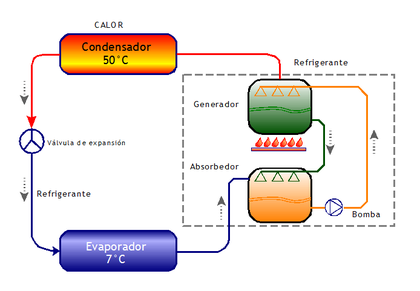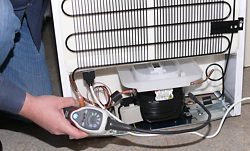Acumuladores de succión para proteger al compresor, evitando el regreso de refrigerante líquido al mismo. Compatible con los refrigerantes CFC, HCFC y HFC comerciales y aceites correspondientes.
- Protege al compresor contra golpes de líquido, evitando el retorno de refrigerante o aceite líquido
- Orificio dosificador para el adecuado retorno de aceite y líquido al compresor
- Compatible con los refrigerantes CFC, HCFC y HFC comerciales y aceites correspondientes- Diseñado para operar en un rango de -40 a +4.5ºC de evaporación
- Conexiones de cobre soldar- Pintura electrostática en polvo contra corrosión
- Dispositivo de alivio (fusible) disponible en los tamaños grandes
Acumuladores de succión recomendados en sistemas de refrigeración que operan bajo amplias variaciones de carga térmica y en sistemas de refrigeración de baja temperatura, sujetos a deshielos. Para todos aquellos sistemas riesgosos o propensos al regreso de líquido al compresor.
ingles: Suction accumulators to protect the compressor, preventing the return of liquid coolant thereto. Compatible with CFC, HCFC and HFC for commercial and oils.
- Protects the compressor from liquid slugging, preventing return of liquid refrigerant or oil
- Hole for the proper metering of oil and liquid return to compressor
- Compatible with CFC, HCFC and HFC refrigerants and oils for commercial
- Designed to operate in a range of -40 to +4.5 ° C evaporation
- Soldering copper connections
- Electrostatic powder paint against corrosion
- Relief device (fuse) available in large sizes
Preferred suction accumulators in refrigeration systems which operate under wide variations of thermal load and cooling systems of low temperature, subject to thaw. For those systems prone to risky or return of liquid to the compressor.
| Acumuladores de Succión | |||
CODIGO
|
NO. PARTE
|
CONX. SOLDAR
| |
VC-AS3754
|
2825-AS-375-4
|
1/2''
| |
VC-AS3945
|
2826-AS-394-5
|
5/8''
| |
VC-AS31155
|
2827-AS-3115-5
|
5/8''
| |
VC-AS31156
|
2828-AS-3115-6
|
3/4''
| |
VC-AS31385
|
2829-AS-3138-5
|
5/8''
| |
VC-AS31386
|
2830-AS-3138-6
|
3/4''
| |
VC-AS41005
|
2834-AS-4100-5
|
5/8''
| |
VC-AS41006
|
2835-AS-4100-6
|
3/4''
| |
VC-AS5856
|
2839-AS-585-6
|
3/4''
| |
VC-AS5857
|
2841-AS-585-7
|
7/8''
| |
VC-AS51177
|
2842-AS-5117-7
|
7/8''
| |
VC-AS51347
|
2843-AS-5134-7
|
7/8''
| |
VC-AS51349
|
2844-AS-5134-9
|
1 1/8''
| |
VC-AS51699
|
2845-AS-5169-9
|
1 1/8''
| |
VC-AS516911
|
2846-AS-5169-11
|
1 3/8''
| |
VC-AS61269
|
2849-AS-6126-9
|
1 1/8''
| |
VC-AS613811
|
2850-AS-6138-11
|
1 3/8''
| |
VC-AS620213
|
2851-AS-6202-13
|
1 5/8''
| |

NOMENCLATURA
| Ejemplo: AS-375-4 | |||
AS
|
3
|
75
|
4
|
Modelo
|
Diámetro (pulgadas)
|
Altura (pulgadas)
75 - 7.5 115 - 11.5 126 - 12.6 |
Tamaño de conexión en 1/8'
|





